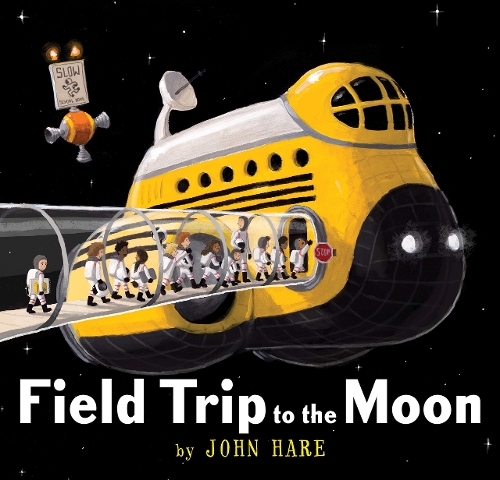Look, I could beat around the bush, but I’m just going to tell you straight: nothing gets the attention of the Caldecott committee like a wordless book. Wordless is Caldecott catnip. So it is with this in mind that I approach Field Trip to the Moon, John Hare’s debut picture book about an outer space field trip gone awry.
 Look, I could beat around the bush, but I’m just going to tell you straight: nothing gets the attention of the Caldecott committee like a wordless book. Wordless is Caldecott catnip. “Yeah, yeah, Travis, what do you know?” Well, I know that my 2014 committee gave Honors to not one but three of them — Flora and the Flamingo (Molly Idle), Mr. Wuffles! (David Wiesner), and Journey (Aaron Becker). The Caldecott is an award for illustration, and a wordless book says, “Hey, you’re interested in illustration? Look at me! I’m ALL illustration!” Getting rid of all that pesky text can have the effect of distilling a book’s distinguished qualities.
Look, I could beat around the bush, but I’m just going to tell you straight: nothing gets the attention of the Caldecott committee like a wordless book. Wordless is Caldecott catnip. “Yeah, yeah, Travis, what do you know?” Well, I know that my 2014 committee gave Honors to not one but three of them — Flora and the Flamingo (Molly Idle), Mr. Wuffles! (David Wiesner), and Journey (Aaron Becker). The Caldecott is an award for illustration, and a wordless book says, “Hey, you’re interested in illustration? Look at me! I’m ALL illustration!” Getting rid of all that pesky text can have the effect of distilling a book’s distinguished qualities.
So it is with all of this in mind that I approach Field Trip to the Moon, John Hare’s debut picture book about an outer space field trip gone awry. It’s wordless, and oh are there some details for the committee to talk about.
Can we first talk about the glorious way the story BEGINS ON THE COVER OF THE DANG BOOK? A class of kids boards an astrobus and (after bright, school bus–yellow endpapers) blasts off through the title and copyright pages, making a soft, perfectly timed lunar touchdown on the opening panoramic spread of the book. That, my friends, is a distinguished example of (from the criteria) “delineation of plot, theme, characters, setting, mood or information through the pictures.”
In an era when illustration notes can sometimes read like pretentious wine list descriptions (“elements of collage with hints of pencil and watercolor; notes of Photoshop and barnwood texture; gouache essences”), Hare keeps it simple: acrylic paint. If we’re talking about “appropriateness of style of illustration to the story, theme or concept” — and we are, because that’s in the Caldecott criteria — this art hits the nail on the head. Humor is not a straight line, and Hare knows it, imbuing everything with a roundness that lets the reader know instantly that this book is not all serious.
But don’t be fooled, because there is plenty of excellence in the execution of this artwork. Of particular note is Hare’s use of light and shading. Both are so effective that the illustrations take on a three-dimensional, almost claymation quality. If the great Aardman animation studio decided to make a picture book, it might look a little like this.
So, while wordless can draw the Caldecott committee in, the book has to give them reason to get excited (see: checking boxes in the criteria). Field Trip to the Moon does this, and here’s hoping it makes its way into the committee discussion.
ALREADY A SUBSCRIBER? LOG IN
We are currently offering this content for free. Sign up now to activate your personal profile, where you can save articles for future viewing.








Add Comment :-
Comment Policy:
Comment should not be empty !!!
Julie Danielson
Tess, I had not noticed that about the LOC note. Interesting! I do love that Hare illustrates the main character such that gender can be open to readers' interpretations.
Posted : Oct 13, 2019 03:30
Tess P
I love this book and can totally see it making the podium and plan to heavily support it in my Mock Caldecott groups. I have an issue with the LOC cataloguing in publication data that is printed inside the book though - why - when the book jacket explicitly refers to the protagonist as "the student" and the illustrations give literally nothing about the kid's sex/gender, does the LOC call her a girl? Spoiler alert: read no further if you haven't yet seen this gem of a book! The final illustration shows a child with chin length messy hair - and indeterminate facial features (with white freckled skin) I don't see girl or boy in this picture- I just see kid, helmet on or off, why make the kid a girl in the cataloguing description, why not say "a child is accidently left behind..." ? I think it should be changed to reflect what I assumed to be intention of the book's creator to be ambiguous about the child's sex/gender.Posted : Oct 09, 2019 07:08
Joe Prince
This book washed over me when I cataloged it, but I pulled a bunch of titles last week to look at a little more closely, and I'm adding this to our Mock Caldecott ballot. It's phenomenal in its expressiveness. My favorite image is when the child looks up directly at the reader when aliens crowd behind her - though her face is obscured by the helmet, her body language communicates with cartoonish humor. I can see children really enjoying this book, too.Posted : Oct 07, 2019 12:47